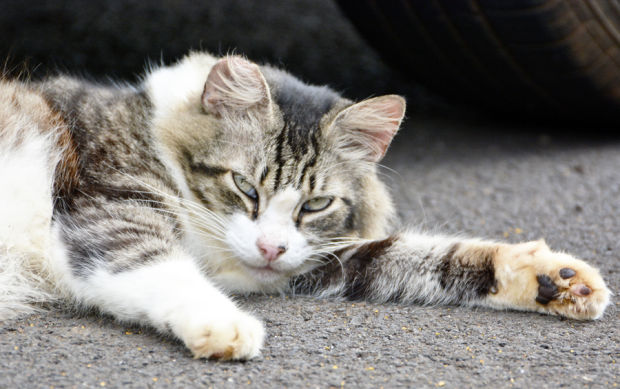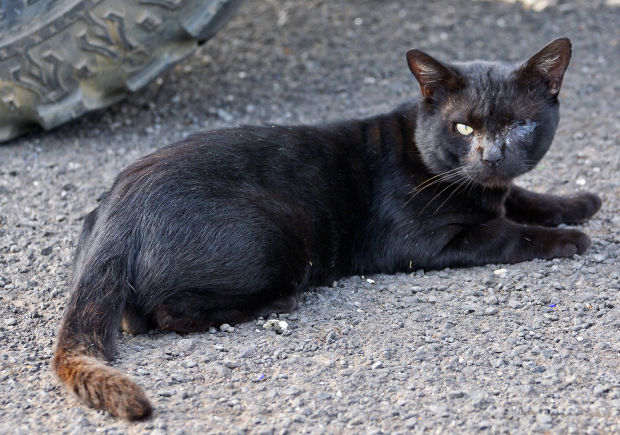LIHUE — The goal is to eradicate them. A County of Kauai task force says officials must step up education efforts, strengthen local laws and use various methods to combat Kauai’s growing feral cat problem. The end game, the nine-member
LIHUE — The goal is to eradicate them.
A County of Kauai task force says officials must step up education efforts, strengthen local laws and use various methods to combat Kauai’s growing feral cat problem.
The end game, the nine-member Feral Cat Task Force concluded, is to have “zero feral, abandoned and stray cats on the island by the year 2025,” according to their 113-page final report.
But how the county goes about eliminating feral cats — up to 20,000 estimated to be roaming the island — is up in the air.
Suggestions ranged from stepping up neuter programs to increased euthanization.
“Everyone on the Feral Cat Task Force agreed that there should be no feral and abandoned cats on the landscape,” Kauai Albatross Network Founder Hob Osterlund, a task force member, wrote in the report. “Not everyone had the same idea of the optimal means to achieve that end.”
What the council does with the recommendation has yet to play out. The task force will present its finding to the County Council July 2. The group formed to determine whether it could find a solution to protecting the island’s endemic birds while curbing the growth of feral cats.
Kauai Humane Society Executive Director Penny Cistaro declined to comment on the report, but said the next possible steps, such as crafting bills, lies in the hands of the Kauai County Council, which called for the group to be formed in 2011.
One council member, however, said something must be done.
“Of course, I’ve lived here my whole life and seen the cat population with my own eyes, so I know it’s a big problem,” Councilman Ross Kagawa said. “We need to do something soon because it’s getting worse every day we wait.”
What suggestions say
The $30,000 study, facilitated by Peter Adler, from Honolulu-based mediation firm Accord 3.0 Consultants, makes some recommendations.
They include strengthening the county’s cat licensing ordinance by releasing more funds for the Kauai Humane Society to hire more humane officers; imposing stiff fines for cat abandonment; and broadening the county’s definition of cat owners to include colony caretakers.
Feeding, sheltering or caring for cats on any county-owned or managed properties, under the proposed rules, would also be prohibited unless explicit permission is given.
County officials, the task force added, should also enforce penalties for owners of stray cats captured away from their own properties.
Not everyone is on board with the recommended changes.
George Wallace, American Bird Conservancy vice president of oceans and islands, questioned the restrictions and said such recommendations could “set the stage for continued conflict.”
“Even if your immediate neighbor agrees to allow your cat to roam onto your property, how can you guarantee the cat will not go to someone else’s yard, the beach park down the street, or the ‘sensitive wildlife area,’” Wallace wrote in testimony to the task force. “We are also concerned that the issue of who owns cats maintained in colonies is left unclear in this document.”
While the exact number is unknown, the task force estimated the feral cat population between 15,000 and 20,000.
To ensure that the county gets a more accurate number, the task force also suggested it obtain “scientific and technical expertise to establish an accurate baseline of the number of owned, feral and stray cat populations.”
Data should also be compiled to determine “an estimated number of native endangered and native threatened birds killed by cats,” the report read.
While group members were divided as to how these management practices should be carried out, many agreed on two key points: bolstering affordable spaying and neutering services and education programs.
“This is something that is worth everyone concerned devoting continued effort to,” Kapaa resident Sue Scott wrote in her testimony to the task force. “It’s not an instant fix, but there is no magic solution, and if this public awareness campaign had been started years ago, we would not have the problem we have today.”
Population control
Among the biggest stumbling blocks the task force was forced to face — and the one that generated the most impassioned responses — were those discussions centered around what population control methods for feral cats would work best on Kauai.
Some residents say bolstering current trap, neuter, release and monitor methods is the most equitable way to gradually stem feral cat population growths over time.
Opponents, however, say those methods are ineffective and say more aggressive measures, including euthanasia, must be considered.
Kauai Community Cat Project President Basil Scott said population numbers in managed cat colonies that undergo a trap, neuter and release regimen quickly stabilize and gradually decrease over time.
Though these colonies are usually created around areas where people commonly feed feral cats, Scott said the illegal dumping of cats, and not the act of feeding, is the problem that must be addressed.
Kauai National Wildlife Refuge Complex Deputy Project Leader Mike Mitchell, however, said he’s not so sure.
The trap, neuter and release method used by many local organizations, he said, “does not work very well and even in the best- managed conditions” because unwanted cats get dumped into colonies and are not trapped in time before they breed.
Waiting years for colony numbers to stabilize and decline, he fears, may be too long to save some of the island’s native forest bird species on the verge of extinction.
“Extinction is forever,” Mitchell wrote.
• Darin Moriki, county government reporter, can be reached at 245-0428 or dmoriki@thegardenisland.com. Follow him on Twitter at @darinmoriki.




